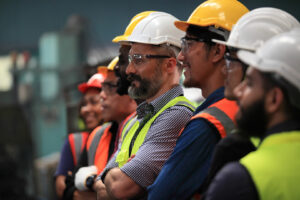
As we reach the midpoint of the year, it’s a great time to reflect on the state of the industry at halftime. How is the industry performing? What have been the key trends and themes emerging for the construction supply chain and how can you prepare for the second half of 2022?
The State of Play
The industry has made a significant recovery post-pandemic on the back of a robust residential market in 2021, which experienced 17.0% growth as per the Construction Products Association (CPA.)
The CPA forecasts that output in the industry will grow by a robust 4.3% in 2022, slowing to 2.5% in 2023 compared to the 13.3% seen in 2021. Housebuilding, the largest sector within the UK construction industry, is expected to remain buoyant while infrastructure will be the major driver for growth. Projects already underway in all sectors give great confidence to the forecast figures.
Construction output fell 0.4% after five consecutive months of growth, as per the Office for National Statistics (ONS) statistics, but this very slight dip is only a monthly snapshot. The ONS revealed that output rose by 2.9 per cent in the three months to April and the level of construction output in April was 3.3 per cent, or £481m, above the February 2020 pre-pandemic level.
So having reviewed the figures, what are the key trends that emerged in the first six months?
2022 – The Year Disruption Became Standard
The most apparent reflection on the first six months of 2022 is the sheer amount of disruption that supply chain teams have had to face. Just when one crisis seemed to disappear, level off or at least calm down a little… another one raised its head.
Heading into 2022, the construction industry was facing considerable supply chain volatility in material shortages – specifically timber – which meant prices were increasing almost daily. This disparity between cost and bid price meant the whole industry was squeezed tighter. Projects were scaled back, delivered late (therefore impacting cash flow) or cancelled altogether.
So just as supply chain teams had tackled a pandemic and the fallout from Brexit, even more issues arose around shortages in labour and materials, inflationary pressure and a geopolitical war in a very influential source of many components and materials.
Raising Resilience
All of this led to a key supply chain theme emerging – resilience.
There isn’t a one-size-fits-all solution to creating resilience in the construction industry, but we’ve noticed three key strategic pillars present in our construction clients that are helping them to ride the wave.
Technology
We may be biased of course, and we work closely with supply chain technology every day… but when facing inevitable volatility, the integration of digital technologies into the supply chain could genuinely help build resilience.
Forward-looking teams have started to bring suppliers, manufacturers and contract management, and materials management onto a single platform – allowing for the analysis and evaluation of all of your data in one place. This allows a pragmatic approach to risk minimisation. This analysis means companies can develop alternate sourcing strategies more quickly
People & Process
If material shortages have meant the squeezing of margins, then finding additional efficiencies and optimisation becomes ever more important. This is also intrinsically linked to the technological and digitisation of the workforce – not only helping them to do more in less time but also transforming their problem-solving approach from reactive to predictive. This will have a compounding effect on the resilience of the business. They can see further ahead with more definitive data to back up decisions.
We appreciate that this is not without difficulty, as developing your data strategy and warehousing and simultaneously embedding analytics as a core competency isn’t something that can be done overnight.
Product Adaptation
The raw material shortage was also affecting pre-built components such as windows and doors, which had catastrophic effects on project profitability and delivery times. These difficulties have led to changes in capabilities within the construction industry to develop modular and pre-fabricated solutions to reduce complexity.
The supply chain challenge isn’t simply one of tech-powered, data-driven supplier management to spread risk – but one where a back-to-the-drawing board approach of re-inventing the wheel should be considered.
In Summary
It’s been a difficult start to the year in the construction industry. Material supply issues have begun to ease significantly and some prices have levelled off and in many cases reduced compared to the insane highs seen at the end of 2021 due to scarcity.
Overall, supply chain disruptions and volatility are expected to be among the biggest challenges in 2022, and the companies that can navigate through them by considering the three strategic pillars above will likely emerge as winners.





